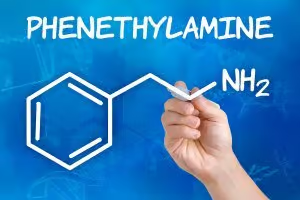Table of Contents
Key Takeaways
- Phenylethylamine (PEA) is a trace amino acid with stimulant and mood-enhancing effects, synthesized from L-Phenylalanine and found in certain foods and chocolate.
- PEA activates TAAR1 and TAAR2 receptors, leading to increased serotonin and dopamine release, potentially helping with anxiety, depression, and ADHD.
- Aging can lead to decreased PEA levels, which may be linked to ADHD, addiction, and neurodegenerative diseases.
- PEA shows promise as an antidepressant and a potential alternative to SSRIs, with ongoing studies for ADHD treatment.
- PEA has a short half-life, which can be extended by using it with a MAO-B inhibitor, and potential side effects include the “cheese effect” and other amphetamine-class side effects.
Phenylethylamine (PEA, 2-phenylethylamine, beta phenylethylamine / β-phenylethylamine, phenethylamine) is a trace amino acid. Your brain naturally converts L-Phenylalanine into Phenylethylamine (PEA).
PEA is not at the top of most nootropic stack choices because its effects are so short-lived. But some neurohackers love PEA for its stimulant and mood enhancing qualities.
The most famous promoter of phenylethylamine was Dr. Alexander Shulgin and his wife Anna. Dr. Shulgin published ‘PiHKAL: A Chemical Love Story’ in 1991. PiHKAL is short for “Phenethylamines I Have Known and Loved”.
Phenylethylamines are a group of phenethylamine derivatives which contain PEA as a backbone. These derivative compounds are formed by replacing one or more hydrogen atoms in the core structure.
This class of PEA compounds include amphetamines, empathogens, stimulants, psychedelics, appetite suppressants, bronchodilators, nasal decongestants, and antidepressants.
One of the more famous PEA derivatives is Methylenedioxymethamphetamine (MDMA or Ecstasy).
Dr. Shulgin developed, tested, and published the formulas for 179 different compounds largely based around the structure of PEA in his book PiHKAL.
In this review we investigate how phenylethylamine (PEA) works in the human brain.
Phenylethylamine helps:
- Anxiety & Depression. PEA activates TAAR1 and TAAR2 receptors which in turn prevents the uptake and boosts the release of the ‘feel-good’ neurotransmitters serotonin and dopamine.
- Neuroprotector. Monoamine oxidase inhibits the catecholamines like dopamine and norepinephrine. Decreases in dopamine levels are implicated in diseases like Parkinson’s. PEA helps boost dopamine and norepinephrine levels. Reducing the symptoms of neurodegenerative diseases.
- Attention Deficit Disorder (ADHD). PEA prevents the reuptake of dopamine and norepinephrine and inhibits their transport. Like the mechanism of action provided by ADHD stimulant meds. Some have found supplementing with PEA as a nootropic has decreased the symptoms of ADHD.
Overview
Phenylethylamine (PEA, 2-phenylethylamine, β-phenylethylamine, phenethylamine) is a trace amine naturally synthesized from L-Phenylalanine in your brain that links to your brain’s trace amine-associated receptor.

Aromatic amino-acid decarboxylase converts phenylalanine to phenylethylamine. This is the same enzyme that converts phenylalanine into dopamine. And it converts it at a rate comparable to the synthesis of dopamine.
But PEA is not retained in neuronal vesicles like dopamine is stored. Instead, monoamine oxidase-B (MAO-B) quickly degrades PEA.[i]
Despite its short half-life, PEA as a nootropic seems to be effective for increasing catecholamine activity by boosting dopamine and norepinephrine.[ii]
PEA can be found naturally in many cacao, algae, fungi, and bacteria as well as clover, beans, peas, and some food products such as Natto and eggs.
PEA is also found in chocolate where it is produced during cacao’s fermentation and roasting process.[iii]
PEA binds to C-protein-coupled receptors TAAR1 and TAAR2, receptors reserved specifically for trace amine use.[iv] These receptors are not used by other major neurotransmitters like dopamine or norepinephrine.
The half-life of PEA taken as a nootropic supplement is only 5 – 10 minutes.[v] Because it’s quickly degraded by monoamine oxidase-B (MAO-B).
Many neurohackers prolong the effects of PEA by using it with a monoamine oxidase-B inhibitor (MAOI) like selegiline (L-Deprenyl), hordenine, or Oat Straw.
How does Phenylethylamine work in the brain?
Phenylethylamine boosts brain health and function in several ways. But two in particular stand out.
- Phenylethylamine decreases depression. PEA naturally boosts the ‘feel-good’ neurotransmitters in your brain called serotonin and dopamine. Studies have shown that depressed patients when tested have lower levels of PEA.[vi]
In fact, some suggest that a PEA deficit may be the cause of depression in the first place. One study had 14 patients with major depression take up to 60 mg per day of Phenylethylamine (PEA) along with 10 mg of selegiline (L-Deprenyl) for up to 50 weeks.
Researchers found that “PEA produces sustained relief of depression in a significant number of patients, including some unresponsive to the standard treatments. PEA improves mood as rapidly as amphetamine but does not produce tolerance.”[vii]
- Phenylethylamine is a mesencephalic enhancer. PEA is considered a mesencephalic enhancer which is defined as “enhancer-sensitive neurons in the brain capable of working in a split-second on a high activity level due to endogenous enhancer substances”.[viii]
This means that PEA stimulates the release of dopamine, norepinephrine, and serotonin in the brain. But unlike stimulant drugs like amphetamine, which release a flood of these neurotransmitters in an uncontrolled manner.
PEA instead only increase the amount of neurotransmitters that get released when a neuron is stimulated by receiving an impulse from a neighboring neuron.
In other words, the pattern of the neurotransmitter release in not changed. But when the neuron would normally release a neurotransmitter, a larger than normal amount is released.[ix]
The result is nearly instantaneous improvements in cognitive performance, attention, awareness, pleasure, libido, and a sense of well-being.
Phenylethylamine is an endogenous (natural or ‘built-in’) amphetamine. This mechanism of action is how prescription ADHD stimulants like Adderall work. And the basis for many Schedule 1 drugs like MDMA[x], LSD, mescaline, and (crystal) methylamphetamine.[xi]
How things go bad
Phenylethylamine (PEA) is naturally metabolized by monoamine oxidase-B (MAO-B). But as we get older, MAO-B levels rise and suppress healthy levels of PEA.
Low PEA levels have been linked to several neurological diseases. And may result in:
↓ Increased chance of ADHD
↓ Increased chance of addiction
↓ Energy levels decline
↓ Working memory and mood decline
↓ Contributing to Parkinson’s Disease
On the other hand, excess levels of PEA has been linked to migraines and paranoid schizophrenia.
Phenylethylamine central nervous system benefits
Phenylethylamine (PEA) quickly crosses the blood-brain barrier once you take it. And you feel its effects right away.
 Activation of TAAR1 receptors inhibit the uptake and induces the release of dopamine, norepinephrine, and serotonin. It’s like turning up the volume of neuron activity.
Activation of TAAR1 receptors inhibit the uptake and induces the release of dopamine, norepinephrine, and serotonin. It’s like turning up the volume of neuron activity.
A higher concentration of all of these neurotransmitters increase feelings of pleasure, boosts motivation, improves memory and cognition, and reinforces impulse control.
PEA naturally maintains and regulates neuronal activity. Preventing over- or under-stimulation. When working as designed, PEA and other trace amines prevent metabolic dysfunction and neurological disorders.
As a neurotransmitter, PEA acts like, and looks similar to amphetamines. And produces effects normally associated with taking a stimulant (like the drug amphetamine Adderall). But unlike amphetamines, and because PEA is endogenous to the brain, side effects and tolerance are avoided.
PEA works in an area of the brain associated with emotions. Resulting in feelings of pleasure, more drive and impulse control, heightened creativity, and better sensory perception.
PEA improves libido, social behavior, a sense of wellbeing, and better overall performance.
PEA is currently being studied and used for the treatment of ADHD, depression, bipolar disorder, cognitive dysfunction like brain fog and poor concentration. And PEA looks promising for treating addiction and eating disorders.
How does Phenylethylamine feel?
PEA is rapidly broken down by monoamine oxidase-B (MAO) so unless you stack PEA with a brain chemical like a MAO-B inhibitor, don’t expect its effects to last. Most experience a peak within 15 minutes and sustained energy for 30 min. to an hour.
If you’re ADHD or ADD, you should see an improvement in mood, attention span, focus and mental clarity. Not quite the same effect you’d get from something like Adderall but with a side benefit of more sociability.
Neurohackers report taking a monoamine oxidase inhibitor (MAOI) supplement 15 minutes before a PEA dose and the effects should last about 2 hours. And there’s no crash like you’d normally experience with a stimulant. Just a general feeling of well-being once it wears off.
Some have reported PEA helped kick the habit of Phenibut or caffeine without going through withdrawal.
As a pre-workout supplement, PEA provides a more intense and focused workout.
Older neurohackers seem to feel even more benefit when using PEA. Likely because monoamine oxidase levels over-power dopamine the older you get. And using PEA, especially with a MAOI helps restore dopamine, the brain chemical called serotonin, and other neurotransmitters that are typically depressed with age.
PEA is a great nootropic for study because you should feel less anxiety, fewer panic attacks and less stress. And more motivation, a better mood, easier to maintain focus, and more energy.
Some report food cravings subside and it’s easier to lose weight.
Phenylethylamine Clinical Research
Phenylethylamine as an Antidepressant
Depression is the 2nd leading cause of disability among ages 15 – 44. By 2030, the World Health Organization predicts depression will be the leading cause of disability worldwide.[xii]
Selective serotonin reuptake inhibitors (SSRI) are the most popular antidepressants prescribed worldwide. SSRIs work by blocking the serotonin transporter and inhibiting the reuptake of the neurotransmitter in your brain called serotonin. Resulting in an increase of serotonin in synapses.
But the problem is SSRIs are slow to act. And come with a host of side effects. The sustained antidepressant effect of Phenylethylamine (PEA) may be an alternative to SSRIs.
A study done in 2008 showed that PEA alters serotonin transporters by interacting with TAAR receptors. Increasing serotonin levels by preventing their reuptake just like prescription SSRIs.
The study suggested that PEA may be a safer treatment for depression than SSRIs.[xiii]
Phenylethylamine for ADHD
The diagnosis of attention deficit hyperactivity disorder (ADHD) has traditionally been done by analysis of symptoms. But measuring PEA levels instead has recently been described as a possible biomarker for diagnosing ADHD.[xiv]
This discovery of a relationship between PEA levels and ADHD has excited researchers. Because it will hopefully improve levels of confidence during ADHD diagnosis. And reduce misdiagnosis and over-medication.
One study of ADHD children medicated with methylphenidate (Ritalin) had significantly higher PEA levels when using methylphenidate.[xv]
PEA binds to the TAAR1 receptor which alters monoamine transporter function. And leads to the inhibition of the reuptake of dopamine, serotonin, and norepinephrine. Which then increases the concentration of these neurotransmitters in neuron synapses.[xvi]
This increase in synaptic concentrations of dopamine can be accomplished by directly blocking the dopamine transporter. Which is how drugs like methylphenidate work to boost dopamine.
So if you are ADHD and crave chocolate, it’s likely because cocao supplies PEA.
Some naturopaths are beginning to prescribe PEA instead of stimulants like amphetamines or methylphenidate to treat ADHD.
Phenylethylamine Dosage
 Phenylethylamine (PEA) suggested dosage for cognitive benefit is 500 mg up to 3-times per day.
Phenylethylamine (PEA) suggested dosage for cognitive benefit is 500 mg up to 3-times per day.
PEA has a half-life of 5 – 10 minutes.[xvii] But the effects of PEA can be extended by using it with a MAO-B inhibitor.
If you do use a potent MAOI like selegiline (l-deprenyl) make sure you keep the dose low (i.e. 2.5 mg) or you’re in danger of inhibiting MAO-A as well. More on the “cheese effect” next.
Dosing more than recommended is NOT a good idea because you’ll likely feel jittery, irritable, get a headache, feel nausea, and very possibly force your heart rate to dangerous levels.
Phenylethylamine Side Effects
“Cheese effect”: Phenylethylamine (PEA) is metabolized by the enzyme MAO-B. And when monoamine oxidase (MAO) is inhibited by eating cheese, or any other prescription or natural MAO inhibitor (MAOI), the combination can result in a potentially dangerous increase in blood pressure.[xviii]
Studies show that selective MAO-B inhibition does NOT produce this cheese effect.[xix]
Examples of MAO-B selective inhibitors include low-dose selegiline (L-deprenyl), hordenine, Polygala Tenuifolia, Oat Straw, Glycyrrhiza uralensis (Chinese licorice root extract), Phellondendron amurense (Amur cork tree bark), Ferula assafoetida extract (resin), and Psoralea corylifolia (Bu Gu Zhi).[xx]
Do not use Phenylethylamine (PEA) if you are using a prescription MAOI like Marplan, Nardil, Azilect or Parnate, or have used one in the last 14 days.
Do not use PEA if you have phenylketonuria (PKU).
Too much PEA can cause irritability, nausea, amplified heart rate, jitteriness, and could be extremely dangerous.
Remember, Phenylethylamine (PEA) is a (natural) endogenous amphetamine. And used irresponsibly could produce the same dangerous side effects as anything else in the amphetamine-class of compounds.
Where to buy Phenylethylamine
Phenylethylamine (PEA) is available in capsules, tablets, and as a bulk powder.
DO NOT make the mistake of buying Phenylalanine instead of Phenylethylamine (PEA). Because it’s NOT the same thing. And is easily overlooked when searching for this nootropic.
You can buy Phenylethylamine in powder form from Bulk Supplements.
If you buy PEA in powder-form, you should invest in a capsule machine and make capsules. Because PEA is a particularly nasty tasting nootropic supplement.
Nootropics Expert Recommendation
 Phenylethylamine 500 mg up to 3-times per day
Phenylethylamine 500 mg up to 3-times per day
I recommend using Phenylethylamine (PEA) as a nootropic supplement.
Your body does synthesize some Phenylethylamine from phenylalanine which comes from foods like beans, cacao, peas, Natto and eggs.
But most of us don’t get enough Phenylethylamine from our diet. So supplementation could help. Phenylethylamine is highly bioavailable, and quickly crosses the blood-brain barrier. So you should feel its effects soon after you take it.
Phenylethylamine is helpful for most neurohackers to combat anxiety, stress, and sleep deprivation. It’ll boost dopamine, norepinephrine, and serotonin levels.
It’s particularly helpful if you take Phenylethylamine prior to a stressful situation, workout, or physically demanding job. And it’s a great nootropic for studying.
Phenylethylamine could be helpful to those dealing with ADHD/ADD. It’s a possible substitute to stimulant meds like Ritalin or Adderall for some people.
PEA will provide the dopamine your brain needs. And doesn’t produce the stimulant crash when it wears off.
PEA works well when stacked with L-Tyrosine (for dopamine), and CDP-Choline and ALCAR (for acetylcholine).
PEA is quickly degraded by monoamine oxidase-B. So to prologue its effects, stack it with a low-dose MAOI-B.
You can buy Phenylethylamine in powder form from Bulk Supplements.









Join The Discussion - 188 comments
Giovanni
November 5, 2022
Hi David.
I’ve read that phenethylamine never enters (intact) into circulation due to either digestion or first-pass metabolism, nor can it pass the blood-brain barrier. Thoughts?
David Tomen
November 7, 2022
Giovanni, the half-life of PEA taken as a nootropic supplement is only 5 – 10 minutes. Because its quickly degraded by monoamine oxidase-B (MAO-B). That’s why you cannot measure it easily once you take it as a supplement because it’ll never show up in any kind of test.
Moe
September 1, 2022
What happens if you take phenylethylamine with adderall?
David Tomen
September 1, 2022
Moe, it would be like doubling or tripling your Adderall dose. Not a very pleasant experience.
Sarah Jet
August 6, 2022
Hi David,
I have been diagnosed with ADHD and am on Vyvanse 70mg which works amazingly well. I would like to take breaks from Vyvanse and am looking for an alternative. It seems phenylethlamine with a MAOI would be the best? If so, is there an MAOI do you think is superior and what doses of each would you recommend? Is there anything else that you’d recommend combining it with to enhance/prolong the effects? Finally, would it be dangerous to take the PEA/MAOI combination with Vyvanse?
Regards,
Sarah
David Tomen
August 9, 2022
Sarah, this is the protocol I formulated for my own Adult ADD and that is now used by 10’s of thousands around the world with or without stimulants: https://nootropicsexpert.com/best-nootropics-for-adhd-add/
andi
June 10, 2022
would like to ask any thoughts on the potential negative interactions associated with Serotonin if one takes PEA while microdosing LSD?
David Tomen
June 11, 2022
Andi, while I’ve tried it and have not done the research on micro-dosing LSD. But I imagine it is contraindicated with PEA.
Lisa Craythorn
March 15, 2022
Hi David. Great article but I have a puzzling question that I cannot find answered on the internet. I have been working with a Functional Medicine Doctor because of anxiety. My brain chemistry test results came back and they’re pretty confusing. But one that is the most confusing is my Phenethylamine. My result is 402 and the Reference Interval is 32-84 nmol/g. I don’t supplement and I don’t know why it is so high. Some other numbers may prove useful.
Result R/I
Seratonin 113 60-125
Dopamine 247 125-250
Norepinephrine 23.6 22-50
Epinephrine 1.3 1.6-8.3
Nor/Epin ratio 18.2 <13
I am trying to figure out what I can do to bring the PEA down. Any thoughts?
Thanks
Lisa
David Tomen
March 17, 2022
Lisa, was this a urine or saliva test? Because if it was it is useless. The only way to measure the amount of these neurotransmitters in your brain is by autopsy which I think you would find inconvenient. To make it even more difficult, and while I do not know how long Phenethylamine last in your brain, serotonin life is about 1 second. Some of the others is less than a second.
I think a better approach for you is what symptoms are you trying to fix? Is it anxiety or depression, or OCD? Or ???
David
July 18, 2022
I took Life Extension’s Comprehensive Neurotransmitter (urine) Test a year ago. I’m 76. At that time I’d been taking low dose deprenyl to maintain dopamine levels, and most days drinking a Rockstar (please don’t judge me) which contains a lot of taurine. The test picked up on both of these. Dopamine levels were normal (155 for 110-200) while taurine measured very high (2033 for 240-900), and others – PEA, tyrosine, tyramine, norepinephrine – measured very low, and about half of everything measured normal.
So I think this test worked for me. It doesn’t directly measure brain chemistry, of course, but LE says the what’s measured in the urine correlates with mental and physical symptoms.
I’d think Lisa’s high PEA score would come from eating a lot of chocolate or fermented food, though she’s probably ruled that out.
David Tomen
July 20, 2022
Thanks for your input David.
Kevin Anderson
March 6, 2022
Hi, I am prescribed Cymbalta which is a norepinephrine uptake inhibitor and wellbutrin which inhibits uptake of dopamine. Would these drugs help the effects of PEA last longer? Thanks, Kevin
David Tomen
March 7, 2022
Kevin, they would not. For that you need a low dose of an MAO-B inhibitor.
Chris
January 4, 2022
Anyone know if this will cause me to fail a fingernail drug test? I’ve read different things online. If it will does anyone have any idea the quantities and frequency that would cause me to fail?
M
March 21, 2022
No. It will not cause you to fail a drug test. It is a naturally occurring molecule, so no worries.
Ed
December 31, 2021
Hi David,
Happy New Years!
Do you know whether or not PEA is safe to take with the following?
Saffron (88.5mg/day 0.3% Safranal)
L-Theanine (200-400mg)
Piracetam
Aniracetam
Mind Lab Pro
Mind Lab Energy
Grapeseed Extract
Ginkgo Biloba
Magtein
NAC
Apha-GPC
Fish Oil
Cordyceps (Militaris)
Creatine (5g/day)
Saffron acts similarly to Methylphenidate, and so I am unsure whether or not adding a second reuptake inhibitor will be dangerous.
L-Theanine gave me cause for concern, because on the label, it warns not to take it with any MAOI (or SSRI) medications. Does this make L-theanine a “cheese effect” risk?
The Racetams raised a flag, because I know how amphetamines and racetams are widely believed to cause excitotoxcitiy (and at the very least, extreme anxiety and panic). Though, I know that methylphenidate and the racetams play much more nicely because of the former’s different reuptake mechanism of action (which seems to be just like PEA in that respect).
Any insights into these safety checks would be greatly appreciated!
David Tomen
January 2, 2022
Ed, PEA is such a short-acting nootropic that it is unlikely to cause a problem with used with any of the other supplements you mentioned. I understand your concern but while I cannot guarantee zero negative side effects the chances of it are extremely low.
Ed
January 2, 2022
Thank you David, that makes sense. Though do you think that principle would still apply if I took PEA with an MAOI (Oat Straw, etc.) to extend its half life?
David Tomen
January 4, 2022
Ed, no, because that is reason those who use PEA choose to use a natural MAOI. And that is to extend its benefits from a single dose.
Ed
January 8, 2022
Hi David,
Just wanted to give a disclaimer for everyone reading this thread:
UNDER NO CIRCUMSTANCES take Saffron Extract with PEA. I tested the waters with combing a mere 50mg of PEA with 88.3mg saffron extract (standardized 0.3% safranal), where I took the saffron 8 hours earlier. After about 10 minutes, I had a full blown panic attack. I felt like I had taken an overdose of amphetamines along with a red bull. My heart rate skyrocketed and I felt like I was going to die. Luckly, I had Xanax on hand, and took 0.5mg. The comination of the Xanax and a walk outside brought me back to ground level about 30 minutes later.
Additional information: I was in a fasted state (approx. 23 hours since last meal), and had eaten nothing that would cause a “cheese” effect. Also, I had taken 400mg of PEA x3 daily with all of my other supplements besides saffron the day before, with no adverse side effects.
My reaction suggests suggests that PEA should not be taken with Methylphenidate, since Saffron acts very similarly. And I would also be even more hesitant when taking it with amphetamines of any kind, since they actively cause the release of neurotransmitters instead of simply preventing their re-uptake – the overstimulation I fear could be unbearable.
David Tomen
January 9, 2022
Ed, good advice and thank you for sharing. If you don’t mind I would appreciate copying and pasting this under the Saffron comments thread as well.
Most of the time this type of adverse reaction is not a problem with ‘most’ natural nootropic supplements. But there are few which are so powerful that they can get you into trouble. Saffron is a potent supplement. And like all natural nootropics must be respected.